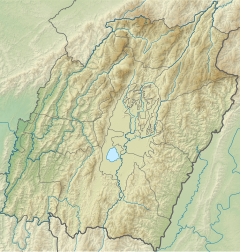| Khuga River | |
|---|---|
  | |
| Location | |
| Country | India |
| State | Manipur |
| Districts | Churachandpur, Bishnupur |
| Physical characteristics | |
| Source | |
| • coordinates | 24°04′56″N 93°38′52″E / 24.0821°N 93.6479°E / 24.0821; 93.6479 |
| Mouth | |
| • coordinates | 24°25′43″N 93°50′16″E / 24.4285°N 93.8378°E / 24.4285; 93.8378 |
| Basin features | |
| Progression | Manipur River |
| River system | Khuga River |
| Waterbodies | Khuga Reservoir |
Khuga River, , is a river in Manipur, India. It originates in the Churachandpur district and flows through the district for much of its course. It enters the Imphal Valley near Torbung, and flows east, joining the Manipur River near Ithai. The Khuga River valley in the Churachandpur district is thickly populated, with the Churachandpur town and numerous villages.
Course
The Khuga River originates in the southern part of the Churachandpur district, and flows north into the Imphal Valley south of Moirang. Another headstream flowing north from the southern borders joins this stream near Hiangtam Khul (24°04′56″N 93°38′52″E / 24.0821°N 93.6479°E / 24.0821; 93.6479 (Source of Khuga)), forming the Khuga River.
A multi-purpose dam called Khuga Dam It was started in 1983 and resumed in 2002 after being at a standstill for a period of time. The work is nearing its completion and the structure was scheduled to be commissioned during 2007. On 12 November 2010 Sonia Gandhi inaugurated the dam and dedicated it to the nation. . It forms a long reservoir, submerging much of the upper valley.
After the dam, the Khuga river flows for about 16 km through the Khuga valley before entering the Imphal Valley near Torbung (in the Bishnupur district).
Near Torbung, streams from Thangjing hills to the west, prominently the Torbung stream, join the Khuga River, as does the outlet stream of the Loktak Lake. The combined river flows east and joins the Imphal River near Ithai to form the Manipur River.
Valley
Khuga River flows through a wide valley, which appears as if it is an extension of the Imphal Valley. The second largest town of Manipur, Churachandpur, lies in the valley.
The Teddim Road, running between the Imphal City and the town of Churachandpur, partly runs through the Khuga river valley.
History
The Khuga River was relatively unknown to the history of Manipur. Its first mention is found in Cheitharol Kumbaba (Manipuri court chronicles) in the year 1712, noting a murder at "Torbung, near Khuga". After the British began to exert their influence in Manipur, The Manipur kingdom extended only to the southern periphery of the Imphal Valley. It was referred to as the "Moirang frontier" in an administrative report in 1876. The Gazetteer of Manipur, published in 1886, makes no mention of the Khuga River and uses the name "Turbung stream" for its lower course running in the Imphal Valley.
Scholar Pum Khan Pau believes that the Khuga River valley might have been traversed by Manipuris for the first time in 1857, when Maharaja Chandrakirti led an expedition to Chin State of Myanmar, then the central base of the Kamhau-Sukte tribes. The Manipuri troops fled "in confusion" after facing the combined troops of Kamhau, Sukte and Sihzang tribes, and returned to the Imphal Valley via a previously "unknown route", which eventually formed the route of the present day Teddim Road along the Khuga River valley.
During World War II, the British improved the Hiangtam road and extended it to Tedim for the defence of eastern frontier of India. The resulting road came to be known as the Teddim Road, running between the Imphal City and the town of Churachandpur. Seven decisive battles were fought along this road between the 17 Division of British India and the 33 Division of Japan. The Japanese reached Churachandpur on 8 April 1944, and four additional battles were fought within Manipur, including one near Torbung. Eventually the Japanese were defeated at Imphal and withdrew with heavy losses.
Notes
- Alternative spellings: Khuka and Khooka.
References
- Parratt, The Court Chronicle of the Kings of Manipur, Vol. 1 (2005), p. 122
- "Annual Administration Report of the Munnipoor Agency, For the year ending 30th June 1874–75", Selections from the Records of the Government of India, Foreign Department, Calcutta: Foreign Department Press, 1874, p. 7 – via archive.org
- ^ Churachandpur District Census Handbook (2011), p. 25.
- Parratt, The Court Chronicle of the Kings of Manipur, Vol. 1 (2005), p. 122. The expression "near Khuga" suggests that the reference could have been to a place rather than a river.
- Dun, E. W. (1992) , Gazetteer of Manipur, Manas Publications, p. 193 – via archive.org (Villages such as Saikot and Saitul are described as being "on the Turbung stream".)
- Pau, Teddim Road (2012), pp. 778–779. sfnp error: no target: CITEREFPau,_Teddim_Road2012 (help)
- Pau, Teddim Road (2012). sfnp error: no target: CITEREFPau,_Teddim_Road2012 (help)
Bibliography
- Churachandpur District Census Handbook (PDF), Directorate of Census Operations, Manipur, 2011
- Parratt, Saroj Nalini Arambam (2005). The Court Chronicle of the Kings of Manipur: The Cheitharon Kumpapa, Volume 1. London: Routledge. ISBN 0-415-34430-1.
- Pau, Pum Khan (2012), "Tedim Road—The Strategic Road on a Frontier: A Historical Analysis", Strategic Analysis, 36 (5): 776–786, doi:10.1080/09700161.2012.712387
- Pau, Pum Khan (2019), Indo-Burma Frontier and the Making of the Chin Hills: Empire and Resistance, Taylor & Francis, ISBN 9781000507454
External links
- Khuga River, OpenStreetMap, retrieved 2 September 2023.
- Tedim Road, OpenStreetMap, retrieved 2 September 2023.
| Hydrography of Manipur | |
|---|---|
| Rivers | |
| Lakes | |
| Dams | |